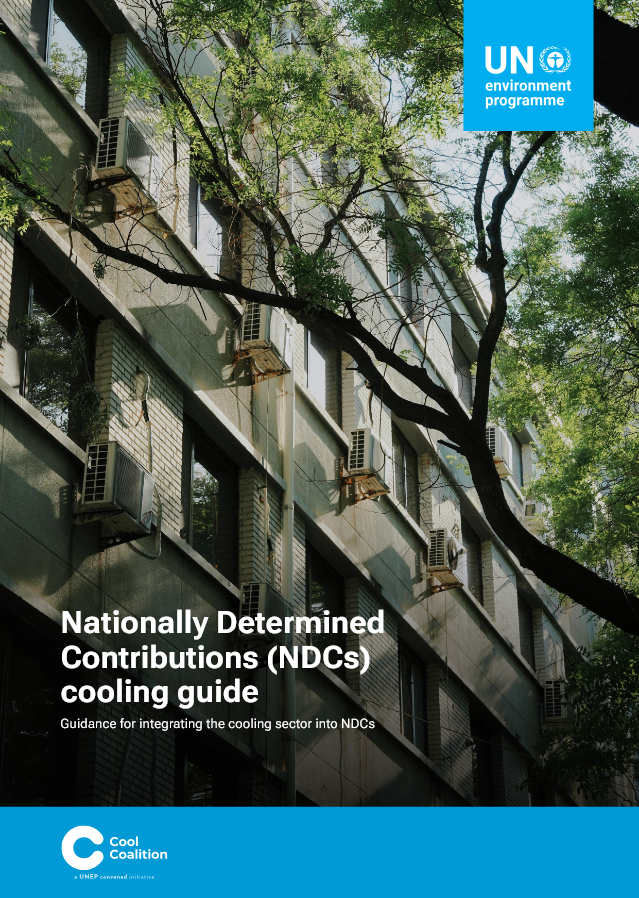UNEP’s NDC Cooling Guidelines 2025

- 26 Jun 2025
In News:
The United Nations Environment Programme (UNEP) has released the NDC Cooling Guidelines 2025, aimed at supporting countries in integrating sustainable cooling strategies into their Nationally Determined Contributions (NDCs) under the Paris Agreement. The initiative addresses both climate mitigation and adaptation challenges posed by rising global temperatures and energy demand.
About the NDC Cooling Guidelines 2025
- Purpose:Provides a structured global framework for countries to incorporate sustainable cooling into national climate action plans, balancing mitigation, adaptation, and developmental needs.
- Developed by:UNEP’s Cool Coalition NDC Working Group, in collaboration with partners like UNDP.
- Primary Objectives:
- Mainstream sustainable cooling in national NDCs.
- Reduce sectoral emissions by 60% by 2050.
- Improve access to cooling for 1.1 billion vulnerable people.
- Establish robust Monitoring, Reporting, and Verification (MRV) mechanisms.
- Align with the Kigali Amendment to the Montreal Protocol and the Global Cooling Pledge.
Global Cooling Landscape: Key Data Points
- Current Impact:
- Cooling accounts for nearly 7% of global GHG emissions, projected to exceed 10% by 2050.
- Cooling consumes 20% of global building electricity, and up to 50% in countries like UAE.
- Access Challenges:1.1 billion people worldwide lack access to efficient and affordable cooling, threatening lives, food security, and healthcare.
- Efficiency Potential:By doubling appliance efficiency, access can expand sixfold without proportionate emission growth.
Challenges in the Cooling Sector
- Rising Emissions:Without immediate policy interventions, emissions from cooling are expected to double by mid-century, increasing climate and energy pressures.
- Access Inequality:Many low-income and rural populations remain exposed to extreme heat due to lack of sustainable cooling.
- Policy Gaps:Only 27% of updated NDCs currently include specific energy efficiency targets related to cooling.
- Gendered Impacts:Women, especially in vulnerable communities, face greater health risks from inadequate cooling and heat stress.
- Reinforcing Heat-Cooling Loop:Increasing temperatures escalate cooling demand, which if met with inefficient systems, leads to more emissions, exacerbating global warming—a vicious cycle.
Six-Step Framework in the Guidelines
- Baseline Assessment:Measure current energy use and refrigerant emissions in the cooling sector.
- Target Setting:Define clear, time-bound targets aligned with national climate priorities.
- Monitoring, Reporting, Verification (MRV):Develop transparent systems to track and report progress.
- Policy Tools:
- Introduce Minimum Energy Performance Standards (MEPS)
- Phase down high-GWP refrigerants
- Promote urban greening and passive cooling techniques
- Governance & Institutional Support:Establish cross-sectoral coordination, incorporating gender-sensitive planning.
- Financing & Equity:Mobilize investments and develop policies to enable equitable access to sustainable cooling technologies.
Country-Level Initiatives
- Nigeria:Integrated National Cooling Action Plan (NCAP) into its NDC, with a focus on heat-resilient rural infrastructure.
- United Arab Emirates (UAE):Adopted district cooling systems and high-efficiency air conditioning in its updated climate roadmap (NDC 3.0).
- Grenada:Committed to becoming the first HFC-free nation, aiming for complete refrigerant phase-down.
